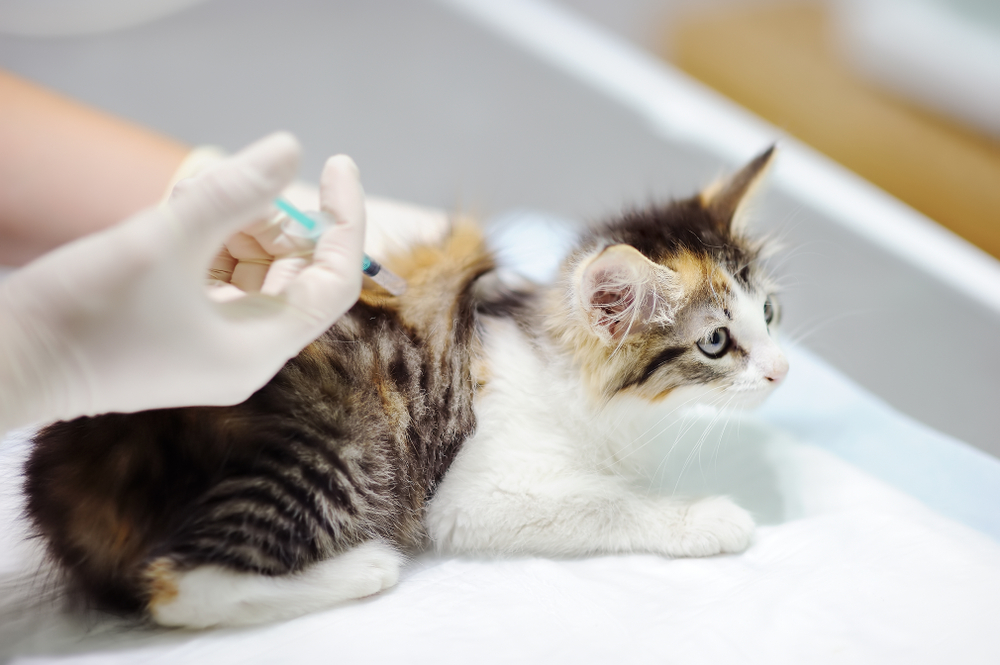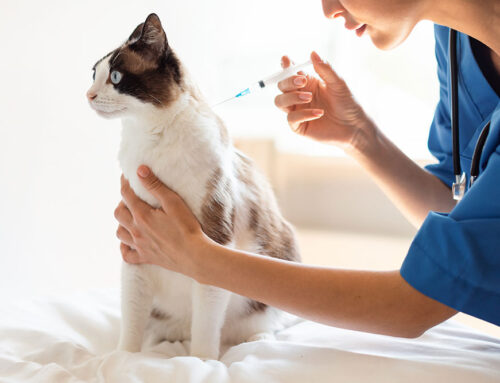Upper respiratory infections (URIs) are extremely common in cats. These highly transmissible illnesses spread rapidly among vulnerable cats, causing classic respiratory signs. Although some respiratory infections can be mild and self-limiting, others can cause cats to experience dangerous complications, including anorexia (i.e., inappetence), pneumonia, and respiratory distress. To help your cat breathe easy and avoid illness, read our Cane Bay Veterinary Clinic team’s six fast URI facts.
#1: Contagious viruses commonly cause upper respiratory infections in cats
Although bacterial pathogens generally cause infection, two contagious viruses, the feline viral rhinotracheitis ([FVR] i.e., herpesvirus type 1) and feline calicivirus (FCV), cause the majority of feline URIs According to the Cornell Feline Health Center, 97% of cats are exposed to FVR during their lifetime, with 80% of them becoming lifelong virus carriers. In addition, at least 90% of cats housed in crowded conditions (e.g., animal shelters, catteries) may be infected with FCV. Because FCV can be transmitted in utero, kittens can be infected before they are born. Although less common, feline respiratory infections can also stem from bacterial causes, including Bordetella bronchiseptica, Chlamydia felis, and Mycoplasma spp.
#2: Upper respiratory infections are easily and rapidly transmitted among cats
URIs spread quickly throughout locations in which cats are housed in close quarters such as in animal shelters, cat boarding facilities, and catteries. In addition to the large cat populations in these locations, the frequent addition of sick cats and the high stress levels of cats housed in these facilities contribute to URIs’ spread. Although any cat can experience a URI, kittens are the most vulnerable because of their undeveloped immune systems. Cats may be exposed to viruses or bacteria in multiple ways, including:
- Interacting with sick cats
- Coming in contact with infectious body fluids (e.g., eye or nasal discharge, saliva)
- Inhaling aerosolized droplets (i.e., produced by sneezing)
- Sharing an infected cat’s dishes, toys, bedding, or litter box
#3: Carrier cats can shed virus particles throughout their life
Unfortunately, despite making a full recovery, nearly all cats who experience a viral URI become lifelong disease carriers. Although these cats appear healthy, they shed the virus through oral or respiratory secretions (e.g., saliva, aerosolized droplets). Throughout their life, an FCV carrier continuously sheds the virus, while an FVR carrier can shed the virus or have a disease relapse (i.e., flare-up) because of stressful events. Stress-inducing events can include relocation, illness, surgery, or household changes (e.g., new or absent pet or family member, persistent noise disruptions).
Because carrier cats are a health risk to vulnerable populations, owners with recovered cats should ensure any new kittens or adopted cats are fully vaccinated before bringing them home. If you are unsure about a new household cat’s vaccine status, practice strict quarantine until the new adoptee has completed the recommended vaccine series.
#4: Upper respiratory infection signs in cats are easy to identify
Affected cats experience illness signs that begin mildly. Intermittent sneezing or watery eyes often quickly progress to include the following:
- Frequent sneezing
- Conjunctivitis
- Clear, green, yellow, or white eye or nasal discharge
- Congestion
- Squinting
- Ulcers in or around the mouth
- Lethargy
- Fever
- Appetite loss
- Enlarged lymph nodes
Congestion disrupts your cat’s ability to smell their food, which can lead to inappetence. Appetite loss that persists for more than three days can lead to life-threatening fatty liver disease (i.e., hepatic lipidosis). So, if your cat stops eating, contact our Cane Bay Veterinary Clinic team. Additional complications associated with severe infections or delayed veterinary treatment can include bacterial infections (e.g., pneumonia, sepsis), dehydration, and chronic eye, respiratory, or periodontal problems.
#5: Cats respond well to early treatment
If your cat is otherwise healthy, a URI will likely run its course in roughly 10 to 14 days. However, no matter how mild your whiskered pal’s URI signs, to minimize your cat’s illness-related discomfort and stress, and prevent complications, you should have our Cane Bay Veterinary Clinic team examine them. We will tailor your cat’s treatment plan, which may include:
- Antibiotics
- Eye medication
- Anti-inflammatory pain medication
- Appetite-stimulating foods
- Immune-boosting supplements or probiotics
As part of your cat’s at-home supportive nursing care, you should gently wipe away eye and nasal discharge because it could clog their nostrils and obstruct their vision. If your cat’s URI is severe, we recommend hospitalization. Inpatient therapies may include intravenous (IV) fluids to resolve dehydration, nebulization treatments to decrease respiratory inflammation, and temporary feeding tube placement to ensure consistent nutrition until your whiskered pal starts eating again.
#6: Routine vaccination protects kittens and cats against severe infection

Recommended vaccination protocols for kittens and cats include a combination vaccine that protects against FVR and FCV, as well as the nonrespiratory virus panleukopenia. Kittens should receive their initial vaccine between 6 and 8 weeks of age, followed by booster vaccines every three to four weeks until they are 16 to 20 weeks of age. Your cat should receive a booster vaccine at 12 months of age, and then every three years. An additional vaccine is available for Bordetella bronchiseptica. However, this is an elective feline vaccine, and we only administer this to cats we deem are at risk.
Although a vaccinated cat can still contract a respiratory virus, they are less likely to suffer a severe infection and will exhibit mild signs. Vaccines do not prevent cats from becoming virus carriers, so you must isolate new unvaccinated household cats and practice strict hygiene to prevent illness exposure.
Feline URIs are nothing to sneeze at, and if left untreated, this uncomfortable condition can cause your cat long-lasting illness. To ensure your cat has the best available URI protection, stay up to date on their routine wellness care by scheduling your whiskered pal’s appointment with our Cane Bay Veterinary Clinic team.







Leave A Comment